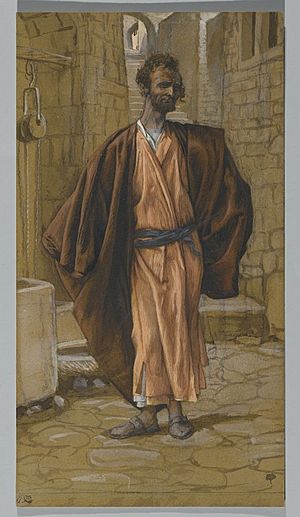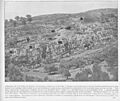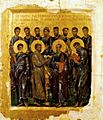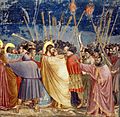Judas Iscariot facts for kids
Judas Iscariot was one of the twelve main followers, called Apostles, of Jesus. The New Testament says he was in charge of the group's money. However, he is most famous for his part in handing Jesus over to the Roman authorities.
His name is also linked to an ancient book called the Gospel of Judas. This book was found written in the Coptic language from the early 300s AD.
The name Judas has come to mean "betrayer" in many languages. In Western art and stories, Judas is known as the first betrayer. He appears in almost all stories about Jesus's final days, and in many modern books and movies too.
Contents
Why Did Judas Betray Jesus?
There are different ideas about why Judas betrayed Jesus. In the earliest story, found in the Gospel of Mark, Judas goes to the chief priests to betray Jesus. They offer him money, but it's not clear if money was his main reason. In the Gospel of Matthew, Judas directly asks how much they will pay him to hand Jesus over.
In the Gospels of Luke and John, it says that the devil influenced Judas. This made him offer to betray Jesus. The Gospel of John also mentions Judas complaining about money spent on expensive perfumes for Jesus. He said it could have been given to the poor. But the Gospel adds that Judas often stole from the apostles' money bag.
One idea is that Judas hoped Jesus would fight against Roman rule in Judea. In this view, Judas was disappointed. He might have betrayed Jesus not for money, but because he loved his country. He might have felt Jesus had failed to free it. Another idea is that Jesus was causing too much excitement. This could lead to problems with the Roman authorities. Some thought Jesus should be stopped until after the Passover holiday, when crowds had gone home.
In 2006, an old Coptic manuscript called the Gospel of Judas was translated. It was written around 200 AD. This text suggests that Jesus might have actually asked Judas to betray him. This would have been to make ancient prophecies come true.
What Happened to Judas?
There are two main accounts in the Bible about what happened to Judas after the betrayal:
- The Gospel of Matthew says that Judas felt very guilty after Jesus was arrested. He returned the money he received to the priests. Then, he ended his own life by hanging himself. The priests could not put the money back into the temple treasury. So, they used it to buy a field called the potter's field. This field was used to bury strangers. The Gospel says this happened to fulfill an old prophecy.
- The Acts of the Apostles tells a different story. It says Judas used the money to buy a field. But then he fell headfirst in that field. He was badly injured, leading to his death. This field is known as Akeldama, which means Field of Blood.
Other Apostles of Jesus
The following people were the other main followers of Jesus:
- Andrew
- Bartholomew
- James of Zebedee
- James of Alphaeus
- John
- Jude Thaddeus
- Matthew
- Peter
- Philip
- Simon the Zealot
- Thomas
- Paul became an apostle later. This was after Jesus' death, resurrection, and return to heaven.
Images for kids
-
The Betrayal Peter raises his sword; Judas hangs himself. Illumination from a western manuscript, c.1504
-
Judas Iscariot (right), leaving the Last Supper, painting by Carl Bloch, late 19th century
-
The Kiss of Judas, by Giotto di Bondone
See also
 In Spanish: Judas Iscariote para niños
In Spanish: Judas Iscariote para niños













